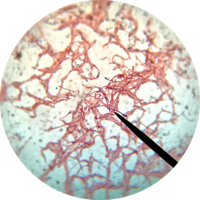Bacillus subtilis/ja: Difference between revisions
Created page with "バチルス・グロビギイ(''Bacillus globigii'')は、近縁種であるが現在では「バチルス・アトロファエウス」として知られている系統学的に異なる種であり、プロジェクトSHAD(別名''プロジェクト112'')において生物兵器模擬物質として使用された。その後のゲノム解析により、これらの研..." Tags: Mobile edit Mobile web edit |
No edit summary |
||
| (8 intermediate revisions by the same user not shown) | |||
| Line 2: | Line 2: | ||
{{Speciesbox | {{Speciesbox | ||
| image = Bacillus subtilis.jpg | | image = Bacillus subtilis.jpg | ||
| image_caption = [[Transmission electron microscopy/ja | | image_caption = [[Transmission electron microscopy/ja|TEM]]写真である。''枯草菌''細胞の断面の[[:en:micrograph|顕微鏡写真]](スケールバー=200[[:en:nanometer|nm]]) | ||
| genus = Bacillus | | genus = Bacillus | ||
| species = subtilis | | species = subtilis | ||
| Line 215: | Line 215: | ||
バチルス・グロビギイ(''Bacillus globigii'')は、近縁種であるが現在では「[[Bacillus atrophaeus/ja|バチルス・アトロファエウス]]」として知られている[[phylogenetic/ja|系統学的]]に異なる種であり、[[Project SHAD/ja|プロジェクトSHAD]](別名''プロジェクト112'')において生物兵器[[Wiktionary:simulant|模擬物質]]として使用された。その後のゲノム解析により、これらの研究で使用された菌株は、異常な高率の[[sporulation/ja|胞子形成]]を示す菌株を意図的に濃縮した産物であることが判明した。 | バチルス・グロビギイ(''Bacillus globigii'')は、近縁種であるが現在では「[[Bacillus atrophaeus/ja|バチルス・アトロファエウス]]」として知られている[[phylogenetic/ja|系統学的]]に異なる種であり、[[Project SHAD/ja|プロジェクトSHAD]](別名''プロジェクト112'')において生物兵器[[Wiktionary:simulant|模擬物質]]として使用された。その後のゲノム解析により、これらの研究で使用された菌株は、異常な高率の[[sporulation/ja|胞子形成]]を示す菌株を意図的に濃縮した産物であることが判明した。 | ||
以前は「納豆菌」として知られていた''枯草菌''の菌株は、日本の食品''[[nattō/ja|納豆]]''や韓国の同様の食品''[[cheonggukjang/ja|チョングッジャン]]''の商業生産に使用されている。 | |||
===21世紀=== | |||
*モデル生物として、''枯草菌''はグラム陽性胞子形成菌の基本的な性質や特性を発見することを目的とした実験室研究によく用いられる。 特に、''枯草菌''の胞子形成の研究から、耐久性のある内胞子の形成の基礎となる基本原理とメカニズムが推測されている。 | |||
* | * その表面結合特性は、安全な放射性核種廃棄物(例:トリウム(IV)やプルトニウム(IV))処理に一役買っている。 | ||
* | * その優れた発酵特性により、高い生成物収率(1リットルあたり20~25グラム)を誇り、[[amylase/ja|アミラーゼ]]やプロテアーゼなどの様々な酵素の生産に使用される。 | ||
* | *枯草菌は[[horticulture/ja|園芸]]や[[agriculture/ja|農業]]において[[soil inoculant/ja|土壌接種剤]]として使用される。 | ||
* | * [[saffron/ja|サフラン]]栽培者にとって、球茎の成長を早め、茎葉のバイオマス収量を増加させることで、何らかの利益をもたらす可能性がある。 | ||
* | * ガス滅菌の際に、滅菌サイクルが正常に完了したことを確認するための「指標生物」として使用される。特に''枯草菌''の胞子は、サイクルが胞子破壊条件に達したことを確認するために使用される。 | ||
* | * B.subtilis''は、受粉や果実の品質に支障をきたすことなく、マミーベリー菌こと''[[Monilinia/ja|Monilinia]]vaccinii-corymbosi''の増殖を防ぐ有用なバイオプロダクト殺菌剤として作用することが判明している。 | ||
* | *代謝的に活性な''枯草菌''細胞も非代謝的に活性な''枯草菌''細胞も、酸素が存在すると金(III)を金(I)と金(0)に還元することが示されている。この生物学的還元は、地質系における金の循環に関与しており、地質系から固体の金を回収するために利用できる可能性がある。 | ||
* | |||
===新規株と人工株=== | |||
* トリプトファン(Trp)ではなく、4-フルオロトリプトファン(4FTrp)を増殖に利用できる''枯草菌''の新規株が単離された。Trpオペロン[[Trp/ja|Trp]]は単一コドンによってのみコードされているため、遺伝暗号においてTrpが4FTrpに置き換わることができるという証拠がある。この実験により、正統的な遺伝暗号は変異可能であることが示された。 | |||
* | * 組換え株pBE2C1とpBE2C1ABは、[[polyhydroxyalkanoates/ja|ポリヒドロキシアルカノエート]](PHA)の生産に使用され、麦芽廃棄物は、より低コストのPHA生産のために、その炭素源として使用することができる。 | ||
* | * [[hyaluronic acid/ja|ヒアルロン酸]]の製造に使用され、ヘルスケアや化粧品の関節ケア分野で使用されている。 | ||
* | * [[Monsanto]]社は、''枯草菌''からコールドスショック・プロテインBを発現する遺伝子を単離し、それを同社の干ばつ耐性トウモロコシ・ハイブリッドMON87460に組み込んだ。 | ||
*[[Monsanto]] | *新菌株は、酵素を分泌して蜜を蜂蜜に変えるように改良された。 | ||
* | |||
< | <span id="Safety"></span> | ||
==Safety== | ==安全性{{Anchor|Safety}}== | ||
===他の動物では=== | |||
=== | ''枯草菌''は、米国FDA[[:en:Center for Veterinary Medicine|獣医学センター]]によって審査され、直接飼料化された微生物製品に使用しても安全性の懸念がないことが判明したため、[[:en:Association of American Feed Control Officials|米国飼料検査官協会]]は、36.14項「直接飼料化された微生物」の下で[[animal feed/ja|動物飼料]]成分としての使用が承認されたものとしてリストアップしている。 | ||
'' | [[:en:Canadian Food Inspection Agency|カナダ食品検査庁]]動物衛生・生産飼料部門は、''Bacillus''培養脱水承認飼料原料を[[silage/ja|サイレージ]]添加物としてSchedule IV-Part 2-Class 8.6に分類し、国際飼料成分番号IFN 8-19-119を付与している。 | ||
一方、''枯草菌''の生存胞子を含むいくつかの飼料添加物は、[[:en:European Food Safety Authority|欧州食品安全機関]]により、動物生産における体重増加のための安全な使用に関して肯定的な評価を受けている。 | |||
===ヒトの場合=== | |||
''枯草菌''の芽胞は調理中に発生する極度の熱に耐えることができる。一部の''枯草菌''株は、腐敗したパン生地や焼き菓子において、長鎖[[polysaccharide/ja|多糖類]]の細菌産生によって引き起こされる粘着性、筋状の粘着性である、ロープ状腐敗を引き起こす原因となっている。長い間、パンのネバネバは生化学的検査によって''枯草菌''種と特異的に関連していた。 分子アッセイ(ランダム増幅多型DNA PCRアッセイ、[[denaturing gradient gel electrophoresis/ja|変性剤濃度勾配ゲル電気泳動]]分析、[[16S ribosomal DNA/ja|16SリボソームDNA]]のV3領域の塩基配列決定)により、パンの腐敗には''バチルス''種の多様性があることが明らかになった。 | |||
'' | |||
''枯草菌''CU1(1日あたり2×10<sup>9</sup>胞子)を健康な被験者を対象に16週間の試験(プロバイオティクスを10日間投与し、各月ごとに18日間の洗浄期間を設ける。健康な被験者には、同じ手順を4ヶ月間繰り返した)で評価した。その結果、''枯草菌'' CU1は副作用もなく、安全で忍容性が高いことが判明した。 | |||
'' | |||
''枯草菌''およびそれに由来する物質は、食品への安全かつ有益な利用について、さまざまな権威ある機関によって評価されてきた。米国では、[[Food and Drug Administration/ja|食品医薬品局]](FDA)が1960年代初頭に発行した意見書により、''枯草菌''由来の[[carbohydrase/ja|カルボヒドラーゼ]]やプロテアーゼ酵素など、微生物由来のいくつかの物質が[[generally recognized as safe/ja|一般に安全と認められる]](GRAS)として指定された。この見解は、それぞれの生物の非病原性・非毒原性菌株の使用と、現行の適正製造規範の使用を前提としたものであった。FDAは、''枯草菌''株由来の酵素は1958年1月1日以前から食品に一般的に使用されており、''枯草菌''の非毒素原性・非病原性株は広く入手可能で、様々な食品用途に安全に使用されてきたと述べている。これには、日本で一般的に食べられている''[[Natto/ja|納豆]]'状の納豆の消費も含まれ、1グラムあたり10<sup>8</sup>もの生菌が含まれている。納豆は、健康的な腸内細菌叢と[[vitamin K2/ja|ビタミンK<sub>2</sub>]]の摂取に貢献することが認められている。このように広く使用されてきた長い歴史の中で、''納豆''は''枯草菌''の存在に起因する可能性のある有害事象に関与していない。納豆とその主成分である''枯草菌''は、日本の[[:en:Ministry of Health, Labour, and Welfare|厚生労働省]]が健康保持に効果があるとして認可した特保(特定保健用食品)である。 | |||
'' | |||
''枯草菌''は[[:en:European Food Safety Authority|欧州食品安全機関]]から「適格な安全推定」のステータスを与えられている。 | |||
'' | |||
==こちらも参照== | ==こちらも参照== | ||
Latest revision as of 23:05, 17 April 2024
| Bacillus subtilis/ja | |
|---|---|

| |
| TEM写真である。枯草菌細胞の断面の顕微鏡写真(スケールバー=200nm) | |
| Scientific classification | |
| Domain: | Bacteria |
| Phylum: | Bacillota |
| Class: | Bacilli |
| Order: | Bacillales |
| Family: | Bacillaceae |
| Genus: | Bacillus |
| Species: | subtilis
|
| Binomial name | |
| subtilis (Ehrenberg 1835)
Cohn 1872 | |
| Synonyms | |
| |
枯草菌(Bacillus subtilis)は、hay bacillusまたは、grass bacillusとして知られ、グラム陽性でカタラーゼ陽性の細菌であり、土壌や反芻動物、ヒト、海綿の消化管に生息する。バチルス属の一員として、枯草菌は棒状であり、強靭で保護的な内胞子を形成することができるため、極端な環境条件にも耐えることができる。枯草菌は歴史的に偏性好気性菌に分類されてきたが、通性嫌気性菌であるという証拠も存在する。枯草菌は最もよく研究されたグラム陽性菌であり、細菌の染色体複製と細胞分化を研究するモデル生物であると考えられている。分泌型酵素産生のチャンピオン菌のひとつであり、バイオテクノロジー企業によって工業的規模で利用されている。
解説
枯草菌はグラム陽性の細菌で、棒状でカタラーゼ陽性である。当初はChristian Gottfried EhrenbergによってVibrio subtilisと命名され、1872年にFerdinand CohnによってBacillus subtilisと改名された(subtilisはラテン語で「細い、薄い、細長い」を意味する)。枯草菌の細胞は典型的な棒状で、長さ約4-10μm、直径0.25-1.0μm、定常期の細胞容積は約4.6fLである。
他のバチルス属のメンバーと同様に、温度や乾燥などの極端な環境条件に耐えるために内胞子を形成することができる。枯草菌は通性嫌気性菌であり、1998年までは偏性好気性菌と考えられていた。枯草菌は鞭毛虫が多く、液体中を素早く移動する能力を持つ。
枯草菌は遺伝子操作に非常に従順であることが証明され、実験室での研究、特に細胞分化の単純化された例である胞子形成のモデル生物として広く採用されるようになった。実験室のモデル生物としての人気という点では、枯草菌は、広く研究されているグラム陰性細菌である大腸菌と同等のグラム陽性細菌と見なされることが多い。
特徴
枯草菌のコロニー、形態学的、生理学的、生化学的特性を下表に示す。
| テストタイプ | テスト | 特徴 |
| コロニー特徴 | サイズ | ミディアム |
| タイプ | ラウンド | |
| 色 | 白っぽい | |
| 形 | 凸型 | |
| 形態学的特徴 | 形 | 棒状 |
| 生理的特徴 | 運動能力 | + |
| 6.5%NaClでの成長 | + | |
| 生化学的特性 | グラム染色 | + |
| オキシダーゼ | - | |
| カタラーゼ | + | |
| 酸化性-発酵性 | 発酵性 | |
| 運動能力 | - | |
| メチルレッド | - | |
| フォーゲス・プロスカウアー | + | |
| インドール | - | |
| H2S生成 | + | |
| ウレアーゼ | - | |
| 硝酸塩還元酵素 | + | |
| β-ガラクトシダーゼ | + | |
| 加水分解 | ゼラチン | + |
| エースクリン | + | |
| カゼイン | + | |
| トゥイーン40 | + | |
| トゥイーン60 | + | |
| トゥイーン80 | + | |
| 酸生成 | グリセロール | + |
| ガラクトース | + | |
| D-グルコース | + | |
| D-フルクトース | + | |
| D-マンノース | + | |
| マンニトール | + | |
| N-アセチルグルコサミン | + | |
| アミグダリン | + | |
| マルトース | + | |
| D-メリビオース | + | |
| D-トレハロース | + | |
| グリコーゲン | + | |
| D-トゥラノーズ | + |
注:+=プラス、-=マイナス
生息地
この種は土壌の上層に多く生息し、枯草菌はヒトの正常な腸内常在菌であると考えられている。2009年の研究では、土壌に含まれる芽胞の密度(1グラムあたり約106個の芽胞)とヒトの糞便に含まれる芽胞の密度(1グラムあたり約104個の芽胞)を比較した。ヒトの腸内で発見された芽胞の数は、食物汚染による消費のみに起因するには多すぎた。いくつかのハチの生息地では、ミツバチの腸内細菌叢に枯草菌が現れる。枯草菌は海洋環境にも存在する。
枯草菌が腐生性であることを示す証拠がある。研究によると、この細菌は有機物の豊富な土壌で植物成長を示し、栄養分が枯渇すると胞子が形成されることが示されている。さらに、枯草菌は植物の根にバイオフィルムを形成することが示されており、腸内細菌叢によく見られる理由も説明できるかもしれない。おそらく、枯草菌のバイオフィルムを持つ植物を食べた動物は、消化管内でこの細菌の増殖を促進することができるのだろう。枯草菌のライフサイクル全体が消化管内で完結することが示されており、このことは、この細菌が植物の摂取によって腸内に入り、腸内で増殖する能力の結果として存在し続けるという考えに信憑性を与えている。
繁殖
枯草菌は対称的に分裂して2つの娘細胞を作る(二元分裂)か、非対称的に分裂して単一の内胞子を作り、数十年間生存し続けることができ、干ばつ、塩分、極端なpH、放射線、溶媒などの好ましくない環境条件に耐性を持つ。胞子嚢は栄養ストレスのある時に、加水分解を利用して形成され、条件が好転するまで生物が環境中に留まることを可能にする。胞子形成のプロセスの前に、細胞は鞭毛を産生することによって運動性になったり、環境からDNAを取り込んだり、抗生物質を産生したりする。これらの反応は、より好都合な環境を求めて栄養を探し求め、細胞が新たな有益な遺伝物質を利用できるようにする試み、あるいは単に競合を退治する試みと見なされる。
栄養欠乏などのストレス条件下では、枯草菌は胞子形成のプロセスを経る。この過程は非常によく研究されており、胞子形成を研究するためのモデル生物となっている。
胞子形成
枯草菌が胞子形成に入ると、シグマ因子シグマFが分泌される。この因子は胞子形成を促進する。胞子形成隔壁が形成され、染色体が前胞子の中にゆっくりと移動する。染色体の1コピーの3分の1が前胞体にあり、残りの3分の2が母細胞にあるとき、前胞体の染色体断片にはシグマFの遺伝子座があり、前胞体で発現が始まる。母細胞でのシグマFの発現を防ぐために、spoIIABがコードするアンチシグマ因子が発現する。前胞子に残存するアンチシグマ因子(そうでなければ胞子形成を阻害する)は、spoIIAAによってコードされるアンチシグマ因子によって阻害される。SpoIIAAはシグマ因子の遺伝子座の近くに位置するため、前胞子で常に発現している。spoIIAB遺伝子座はシグマF遺伝子座とspoIIAA遺伝子座の近くにはないので、母細胞でのみ発現し、その細胞での胞子形成を抑制し、前胞子での胞子形成を継続させる。母細胞に残存するspoIIAAはspoIIABを抑制するが、spoIIABは常に置換されるため、胞子形成を抑制し続ける。したがって、枯草菌の染色体の遺伝的非対称性とシグマF、spoIIAB、spoIIAAの発現が、枯草菌の胞子形成を決定している。

染色体の複製
枯草菌は細菌の染色体複製の研究に用いられるモデル生物である。単一環状染色体の複製は、一つの遺伝子座である起点(oriC)で始まる。) 複製は双方向に進行し、2つの複製フォークが染色体に沿って時計回りと反時計回りに進行する。染色体の複製は、フォークが染色体地図上で原点と反対側に位置する終端領域に達すると完了する。終端領域には、複製停止を促すいくつかの短いDNA配列(Ter部位)がある。特定のタンパク質がDNA複製のすべてのステップを仲介する。枯草菌と大腸菌の染色体DNA複製に関与するタンパク質を比較すると、類似点と相違点が明らかになる。複製の開始、伸長、終結を促進する基本的な構成要素はよく保存されているが、いくつかの重要な違いが見られる(例えば、一方の細菌にはもう一方の細菌に必須なタンパク質が欠けているなど)。これらの違いは、様々な細菌種がゲノムの複製を行うために採用してきた機構や戦略の多様性を強調している。
ゲノム
枯草菌には約4,100の遺伝子がある。このうち、必須であることが示されたのはわずか192個で、さらに79個が必須であると予測された。必須遺伝子の大部分は、細胞代謝の比較的少数の領域に分類され、約半分が情報処理に、5分の1が細胞外皮の合成と細胞の形と分裂の決定に、そして10分の1が細胞エネルギーに関係していた。
QB928株の全ゲノム配列は4,146,839塩基対、4,292遺伝子を持つ。QB928株は様々なマーカー[aroI(aroK)906 purE1 dal(alrA)1 trpC2]が存在するため、遺伝学的研究に広く用いられている。
2009年、枯草菌ゲノムにおいて、いくつかのノンコーディングRNAが明らかにされた。 マイクロアレイを用いた比較ゲノム解析により、枯草菌のメンバーはかなりのゲノム多様性を示すことが明らかになった。
FsrAは枯草菌に存在する低分子RNAである。FsrAはエフェクターであり、鉄の生物学的利用能が低い時に鉄含有タンパク質をダウンレギュレートする。
魚類のプロバイオティクスとして期待されるBacillus subtilis株WS1Aは、Aeromonas veroniiに対する抗菌活性を有し、Labeo rohitaの運動性Aeromonas敗血症を抑制した。de novoアセンブリーの結果、染色体サイズは4,148,460 bp、オープンリーディングフレームは4,288本と推定された。枯草菌WS1A株ゲノムには、リボフラビン、ビタミンB6、アミノ酸の生合成に関与するタンパク質(ilvD)や炭素利用に関与するタンパク質(pta)など、多くの潜在的遺伝子が含まれている。
形質転換
細菌の自然形質転換は、ある細菌から別の細菌へ、周囲の培地を通してDNAが移行することを含む。枯草菌では、転移されたDNAの長さは1,271kb(100万塩基以上)以上である。転移DNAはおそらく二本鎖DNAであり、染色体全長4,215kbの3分の1以上であることが多い。レシピエント細胞の約7-9%が染色体全体を占めるようである。
レシピエントとなる細菌が、同種の別の細菌から外来DNAを取り込み、染色体に組み換えるためには、コンピテンスと呼ばれる特別な生理的状態にならなければならない。 枯草菌のコンピテンスは、対数増殖の終わり頃、特にアミノ酸が制限された条件下で誘導される。このようなストレスの多い半絶食条件下では、細胞は通常染色体を1コピーしか持たず、DNA損傷が増加する可能性が高い。形質転換がDNA損傷を修復する枯草菌の適応機能であるかどうかを調べるため、紫外線を損傷剤として用いた実験が行われた。これらの実験から、DNAの取り込みを伴うコンピテンスはDNA損傷条件によって特異的に誘導され、形質転換はDNA損傷の組換え修復プロセスとして機能するという結論に達した。
天然のコンピテントな状態は実験室の枯草菌や野外分離株では一般的であるが、工業的に重要な菌株、例えば枯草菌(納豆菌)の中には、外来DNAを分解する制限修飾系の存在により、DNAの取り込みに消極的なものがある。I型制限修飾系エンドヌクレアーゼに欠損を持つ枯草菌(納豆菌)変異体は、交配実験において共役プラスミドのレシピエントとして働くことができ、この特定の枯草菌株のさらなる遺伝子工学への道を開いた。
グリーンケミストリーを採用することで、危険性の少ない材料を使用し、コストを節約しながら、研究者たちは、食品や医薬品産業に有用な化学物質を合成する自然の方法を模倣してきた。 それぞれのDNA鎖は、対応する2本のDNA鎖がジッパーのように結合するときに、同時に特定の化学反応を起こす特定の分子を運び、DNAの相補的な結合に運び込まれた分子同士が、制御された孤立した反応を起こすようにする。 この方法を、多段階の複製過程を自然にたどるある種のバクテリアに用いることで、研究者たちは、バクテリア自身がDNAの複製過程を行うのと同様に、カプセルのように扱うことで、これらの付加された分子が酵素や二次反応に使われる他の分子と相互作用するのを同時に進めることができる。
用途
20世紀

枯草菌の培養液は、抗生物質が登場する以前には、消化管や尿路疾患の治療を助ける免疫賦活剤として世界的に普及していた。1950年代を通じて代替医療として使用されており、消化されると広範囲の免疫活性を顕著に刺激し、特定の抗体(IgM、IgG、IgA)の分泌の活性化やCpGジヌクレオチドの放出による白血球のインターフェロン IFN-α/IFNγ産生活性、サイトカインの放出を含む免疫活性を引き起こし、腫瘍細胞への細胞毒性の発達に重要な働きをする。1946年からアメリカとヨーロッパで免疫刺激補助剤として販売され、ロタウイルスや赤痢などの腸管および尿路疾患の治療に使用されました。1966年、米軍はニューヨーク市の地下鉄駅の格子に5日間bacillus subtilisを撒き、不思議な塵に覆われた際の人々の反応を観察した。その生存能力から、今もそこに存在していると考えられている。
抗生物質バシトラシンは、1945年に「トレイシーI」と名付けられたバチルス・リシェニフォルミスの一種から初めて単離された。現在でも、液体増殖培地の容器でこの品種を増殖させることにより、商業的に製造されている。時間の経過とともに、細菌はバシトラシンを合成し、培地中に抗生物質を分泌する。バシトラシンはその後、化学的処理によって培地から抽出される。
1960年代以降、枯草菌は宇宙飛行実験の実験種として使われてきた歴史がある。その内胞子は、太陽紫外線から保護するダスト粒子によってコーティングされていれば、宇宙空間で6年間生存することができる。これは宇宙生物学放射線アセンブリ、EXOSTACK、EXPOSEなどの宇宙空間での極限環境生存指標として使用されてきた。
枯草菌の野生型天然分離株は、突然変異誘発と淘汰の家畜化過程を経た実験室株と比較して、作業が困難である。これらの菌株は、しばしば形質転換(環境DNAの取り込みと統合)、増殖の能力が向上しており、「野生」で必要とされる能力を失っている。 そして、この説明に当てはまる菌株は何十種類も存在するが、「168」と指定された菌株が最も広く使われている。168株は枯草菌マールブルグ株のX線突然変異誘発の後に単離されたトリプトファンオーソトロフ菌であり、形質転換効率が高いため研究に広く用いられている。

バチルス・グロビギイ(Bacillus globigii)は、近縁種であるが現在では「バチルス・アトロファエウス」として知られている系統学的に異なる種であり、プロジェクトSHAD(別名プロジェクト112)において生物兵器模擬物質として使用された。その後のゲノム解析により、これらの研究で使用された菌株は、異常な高率の胞子形成を示す菌株を意図的に濃縮した産物であることが判明した。
以前は「納豆菌」として知られていた枯草菌の菌株は、日本の食品納豆や韓国の同様の食品チョングッジャンの商業生産に使用されている。
21世紀
- モデル生物として、枯草菌はグラム陽性胞子形成菌の基本的な性質や特性を発見することを目的とした実験室研究によく用いられる。 特に、枯草菌の胞子形成の研究から、耐久性のある内胞子の形成の基礎となる基本原理とメカニズムが推測されている。
- その表面結合特性は、安全な放射性核種廃棄物(例:トリウム(IV)やプルトニウム(IV))処理に一役買っている。
- その優れた発酵特性により、高い生成物収率(1リットルあたり20~25グラム)を誇り、アミラーゼやプロテアーゼなどの様々な酵素の生産に使用される。
- 枯草菌は園芸や農業において土壌接種剤として使用される。
- サフラン栽培者にとって、球茎の成長を早め、茎葉のバイオマス収量を増加させることで、何らかの利益をもたらす可能性がある。
- ガス滅菌の際に、滅菌サイクルが正常に完了したことを確認するための「指標生物」として使用される。特に枯草菌の胞子は、サイクルが胞子破壊条件に達したことを確認するために使用される。
- B.subtilisは、受粉や果実の品質に支障をきたすことなく、マミーベリー菌ことMoniliniavaccinii-corymbosiの増殖を防ぐ有用なバイオプロダクト殺菌剤として作用することが判明している。
- 代謝的に活性な枯草菌細胞も非代謝的に活性な枯草菌細胞も、酸素が存在すると金(III)を金(I)と金(0)に還元することが示されている。この生物学的還元は、地質系における金の循環に関与しており、地質系から固体の金を回収するために利用できる可能性がある。
新規株と人工株
- トリプトファン(Trp)ではなく、4-フルオロトリプトファン(4FTrp)を増殖に利用できる枯草菌の新規株が単離された。TrpオペロンTrpは単一コドンによってのみコードされているため、遺伝暗号においてTrpが4FTrpに置き換わることができるという証拠がある。この実験により、正統的な遺伝暗号は変異可能であることが示された。
- 組換え株pBE2C1とpBE2C1ABは、ポリヒドロキシアルカノエート(PHA)の生産に使用され、麦芽廃棄物は、より低コストのPHA生産のために、その炭素源として使用することができる。
- ヒアルロン酸の製造に使用され、ヘルスケアや化粧品の関節ケア分野で使用されている。
- Monsanto社は、枯草菌からコールドスショック・プロテインBを発現する遺伝子を単離し、それを同社の干ばつ耐性トウモロコシ・ハイブリッドMON87460に組み込んだ。
- 新菌株は、酵素を分泌して蜜を蜂蜜に変えるように改良された。
安全性
他の動物では
枯草菌は、米国FDA獣医学センターによって審査され、直接飼料化された微生物製品に使用しても安全性の懸念がないことが判明したため、米国飼料検査官協会は、36.14項「直接飼料化された微生物」の下で動物飼料成分としての使用が承認されたものとしてリストアップしている。 カナダ食品検査庁動物衛生・生産飼料部門は、Bacillus培養脱水承認飼料原料をサイレージ添加物としてSchedule IV-Part 2-Class 8.6に分類し、国際飼料成分番号IFN 8-19-119を付与している。 一方、枯草菌の生存胞子を含むいくつかの飼料添加物は、欧州食品安全機関により、動物生産における体重増加のための安全な使用に関して肯定的な評価を受けている。
ヒトの場合
枯草菌の芽胞は調理中に発生する極度の熱に耐えることができる。一部の枯草菌株は、腐敗したパン生地や焼き菓子において、長鎖多糖類の細菌産生によって引き起こされる粘着性、筋状の粘着性である、ロープ状腐敗を引き起こす原因となっている。長い間、パンのネバネバは生化学的検査によって枯草菌種と特異的に関連していた。 分子アッセイ(ランダム増幅多型DNA PCRアッセイ、変性剤濃度勾配ゲル電気泳動分析、16SリボソームDNAのV3領域の塩基配列決定)により、パンの腐敗にはバチルス種の多様性があることが明らかになった。
枯草菌CU1(1日あたり2×109胞子)を健康な被験者を対象に16週間の試験(プロバイオティクスを10日間投与し、各月ごとに18日間の洗浄期間を設ける。健康な被験者には、同じ手順を4ヶ月間繰り返した)で評価した。その結果、枯草菌 CU1は副作用もなく、安全で忍容性が高いことが判明した。
枯草菌およびそれに由来する物質は、食品への安全かつ有益な利用について、さまざまな権威ある機関によって評価されてきた。米国では、食品医薬品局(FDA)が1960年代初頭に発行した意見書により、枯草菌由来のカルボヒドラーゼやプロテアーゼ酵素など、微生物由来のいくつかの物質が一般に安全と認められる(GRAS)として指定された。この見解は、それぞれの生物の非病原性・非毒原性菌株の使用と、現行の適正製造規範の使用を前提としたものであった。FDAは、枯草菌株由来の酵素は1958年1月1日以前から食品に一般的に使用されており、枯草菌の非毒素原性・非病原性株は広く入手可能で、様々な食品用途に安全に使用されてきたと述べている。これには、日本で一般的に食べられている納豆'状の納豆の消費も含まれ、1グラムあたり108もの生菌が含まれている。納豆は、健康的な腸内細菌叢とビタミンK2の摂取に貢献することが認められている。このように広く使用されてきた長い歴史の中で、納豆は枯草菌の存在に起因する可能性のある有害事象に関与していない。納豆とその主成分である枯草菌は、日本の厚生労働省が健康保持に効果があるとして認可した特保(特定保健用食品)である。
枯草菌は欧州食品安全機関から「適格な安全推定」のステータスを与えられている。
こちらも参照
外部リンク
 Media related to Bacillus subtilis/ja at Wikimedia Commons
Media related to Bacillus subtilis/ja at Wikimedia Commons- SubtiWiki "up-to-date information for all genes of Bacillus subtilis"
- Bacillus subtilis Final Risk Assessment on EPA.gov. Archived from the original on 2015-09-09.
- Bacillus subtilis genome browser
- Type strain of Bacillus subtilis at BacDive - the Bacterial Diversity Metadatabase

